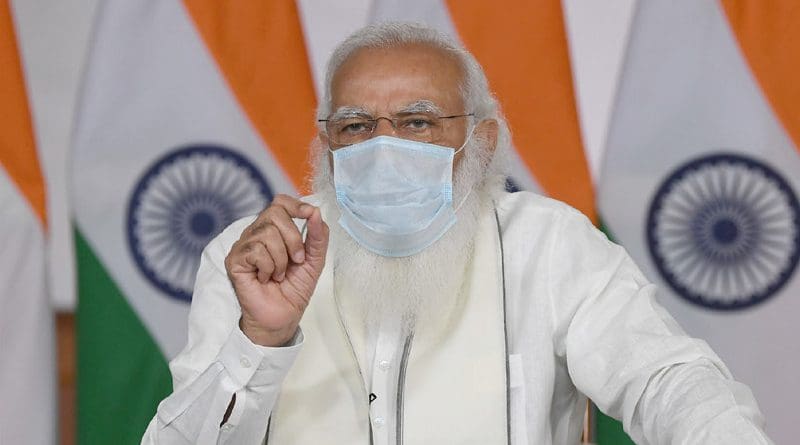Modi’s Reforms And Growth: Hamstrung By Antiquated Bureaucracy And Red Tape – Analysis
In a recent round up meeting with NHAI, flagging the issue of delay in projects, the disgruntled Prime Minister Narendra Modi, asked Cabinet Secretary to prepare a dossier of babus who were responsible for the delay in projects. This signaled Prime Minister’s frustration with bureaucracy and a warning to deal with babus with iron hands who are engulfed by red tape, which caused his reforms failed to give success and windfall to the people.
Prime Minister Narendra Modi forcibly retired many senior bureaucrats in his second term. He vented ire against the IAS officers in Parliament. He chided civil servants, blaming them to make the growth as their hostage. He lamented the despair of million of hapless Indians.
Five years ago, Prime Minister Modi simplified the bureaucracy by reducing various regulations and procedures, asserting online applications extensively to curb the antiquated bureaucracy and red tape. But, they were yet to be translated to propel up the growth. Most of the reforms were parked in papers. Civil servants were hobbled in efforts to turn Modi’s strong and abruptly reforms in effective bureaucracy and generate fruitful results.
As a result, GDP growth could not keep pace with reforms. It slipped from 8 percent in 2016-17 to 4 percent in 2019-20 and entered in contraction in 2020-21 for the first time in decades
Viewing the bureaucracy a major hindrance to the implementation of the reforms, DOPT (Department of Personal and Training) decided to design and develop FRAC ( Framework of Roles, Activities and Competence) for civil servants. A background paper was launched in November 2020 to give a new face of bureaucracy. Indian civil service, which was built up in 1858, continued with similar ethos and work culture, without keeping pace with the reforms in the economy and social development in the country.
Realizing that there were not substantive progress in the performance of bureaucracy even after departmental training, Government of India launched National Programme for Civil Service Capacity Building ( NPCSCB) , known as Mission Karmayogi’s Integrated Government Online Platform (IGOT) initiative. FRAC is an integral part of Mission Karmayogi initiative. It embarks on three characteristics for each individual position within all government ministries, departments and organizations. One of the key objectives of the entire process is to test the competence of officials . The project will initially cover 4.6 million Central Government employees and thereafter it will be extended to 20 million government employees
Attempts were made to reform the bureaucracy time to time . Almost all Government departments have their own training facilities But, they were hindered by lack of development of the mindsets. They failed to update their bureaucracy with modern thinking for less red tape governance. In 1986, former Prime Minister Rajiv Gandhi launched a week’s annual training for government employees. To entice, he proposed 30 percent additional remuneration for all trainees. But, soon the initiative went in vain. Trainers said, “it was difficult to teach new tricks to old dogs”. The Government was caught in controversy with seniors resenting the perk up in remuneration of their juniors.
Even a simple thing is entangled by various levels of approvals. Any action, even in emergency, is approved only after the relevant files move from one table to another. Eventually, the significance of emergency is buried. Only the files move, the actual work is seldom done. Scarcity of oxygen concentrators during COVID pandemic is a case in point.
It is easier to meet the Minster than a Secretary or Joint Secretary. Ministers formulate policies, perceiving the nerves of the people. Babus deliver without the public perceptions. Because babus are not accountable to the populace, unlike Minister.
Any call to a senior bubu is responded by private secretary , “Boss is too busy” . Any clarification of the policy or spade of action of the grievances is either not replied or even if it is responded, the usual reply is “matter has been referred to the concerned department” , which is never monitored and replied.
A survey by Lokniti CSDS ( Centre for the Study of Developing Societies) revealed that majority of the respondents observed it was difficult to get work done at government offices without connections or bribes. . Most of them expressed their distrust and dependence on government offices and preferred going to political parties for getting their work done.
Ironically, even the Economic Survey of India, a pre-budget official document, vent frustration over the bureaucracy. Manufacturing sector is embroiled in the nexus of multiple rules and procedures between Centre and State. It takes 18 days to start a business in India as compared to 8 days in China. A new manufacturing sector has to conform 6,796 compliances. To open a restaurant in New Delhi, one needs 26 licenses , as compared to four in China.
Bureaucracy is strongly criticized for protection by the Constitution under Article 311. Article says bureaucrats can not be removed without enquiry. Incidentally, the significance of procedures in the enquiry laid down is such that a babu can literally get away from the accusation of negligence and red tape, if they are committed according to procedures. The procedures are designed in such way that a large number of employees are involved and if they go wrong, no one can be held responsible for the outcome.
Given these, how the babus held responsible for delay in road projects can be identified?

